|
Posted: 1/28/2017 8:05:12 PM EDT
[Last Edit: TNVC]
There has been a lot of interests lately with using NV with telescopes. We amateur astronomers are always fighting for light while peering into deep sky objects and using a NVD makes hunting for the deep spiral galaxies, nebual, etc a whole lot easier. We have some new NV adapters we have been working with one of THE most brilliant amateur astronomers Al Nagler founder and owner of Tele Vue.
Feel free to post your pics and setups, as so many have some great DIY's out there. Below, my setup as I get ready to peer into some blackness tonight. 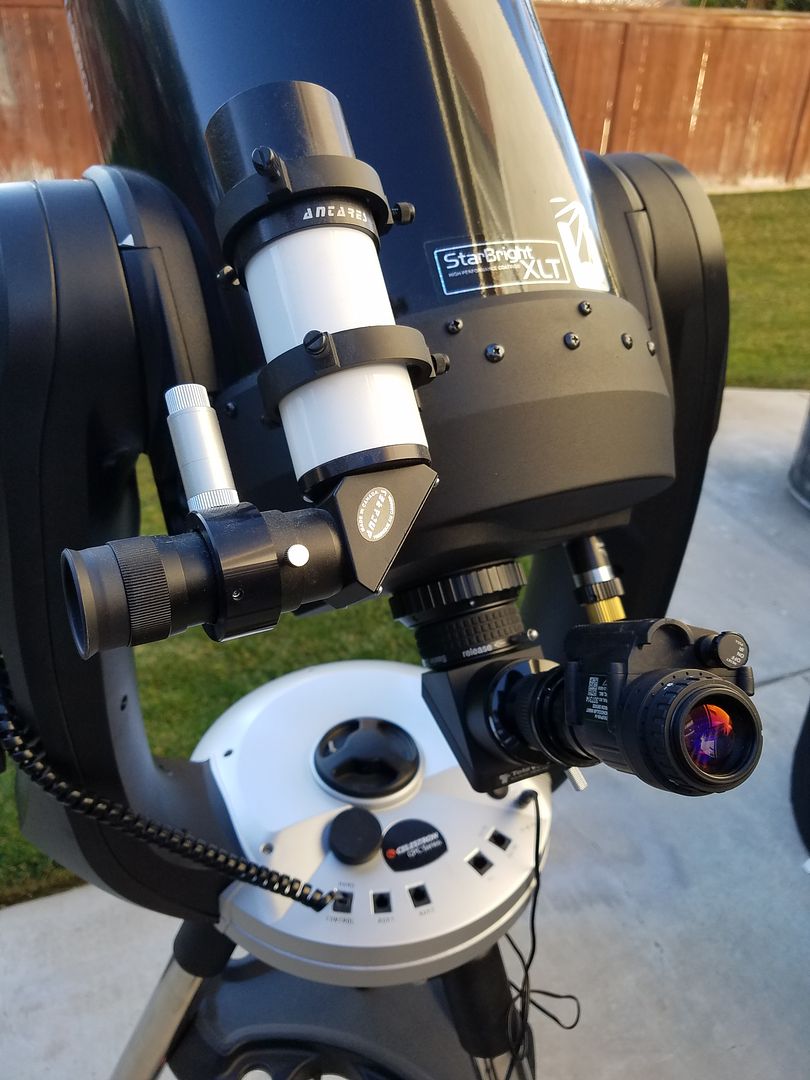
|
|
|
Tactical Night Vision Corporation - TNVC, INC.
http://www.tnvc.com [email protected] (909) 796-7000 "Eliminating our adversaries 940nm at a time" |
|
Great idea for a thread and nice set-up Vic!
It will be nice to share ideas about how to get the most out of NV astronomy. Dual NV Mount This is one of the ways that I set up for NV. The SCT gives high mag narrow FOV and the little frac is ultra wide FOV. Sorry for the link, I can't embed photos. |
|
|
|
|
I just started using this set-up. It's an NVD Micro mounted on a mini ball head attached via a Picatinny rail to the main finder. It makes finding faint emission nebulae in the main scope much easier and provides a great FOV.
NVD Micro as Finder |
|
|
|
|
Originally Posted By TNVC:
There has been a lot of interests lately with using NV with telescopes. We amateur astronomers are always fighting for light while peering into deep sky objects and using a NVD makes hunting for the deep spiral galaxies, nebual, etc a whole lot easier. We have some new NV adapters we have been working with one of THE most brilliant amateur astronomers Al Nagler founder and owner of Tele Vue. Feel free to post your pics and setups, as so many have some great DIY's out there. Below, my setup as I get ready to peer into some blackness tonight. http://img.photobucket.com/albums/v621/Clutch99/20170128_154848_zps1pee8nvq.jpg View Quote Nice! Looking forward to some pictures through that setup. |
|
|
|
|
I will never forget the night I watched a totally insane meteor shower for about 3 hours with a couple of perfect TNV/PVS14's. There was no moon and I was in the middle of nowhere on a mountain top so there was 0 ambient light.
It was like world war 3 had started and the entire cast of star wars had shown up to participate. |
|
|
|
|
Originally Posted By KayakSteve:
Great idea for a thread and nice set-up Vic! It will be nice to share ideas about how to get the most out of NV astronomy. Dual NV Mount This is one of the ways that I set up for NV. The SCT gives high mag narrow FOV and the little frat is ultra wide FOV. Sorry for the link, I can't embed photos. View Quote Look for that Insert Image link icon on the top of the tool bar when making a thread. Insert the direct link of your image from Photobucket 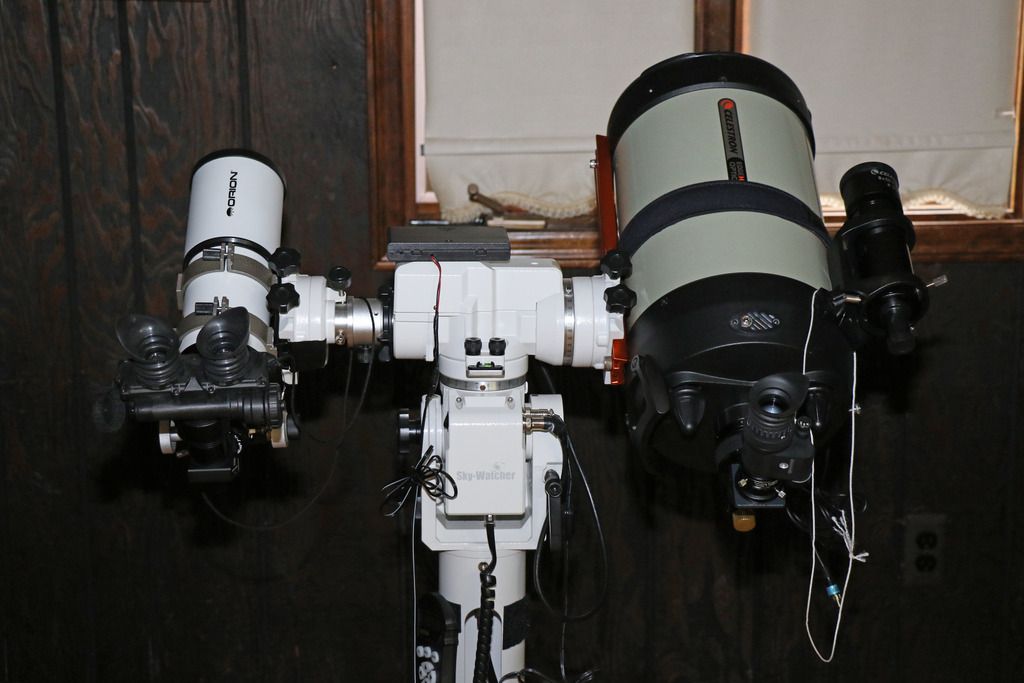
|
|
|
Tactical Night Vision Corporation - TNVC, INC.
http://www.tnvc.com [email protected] (909) 796-7000 "Eliminating our adversaries 940nm at a time" |
|
Originally Posted By KayakSteve:
I just started using this set-up. It's an NVD Micro mounted on a mini ball head attached via a Picatinny rail to the main finder. It makes finding faint emission nebulae in the main scope much easier and provides a great FOV. NVD Micro as Finder View Quote 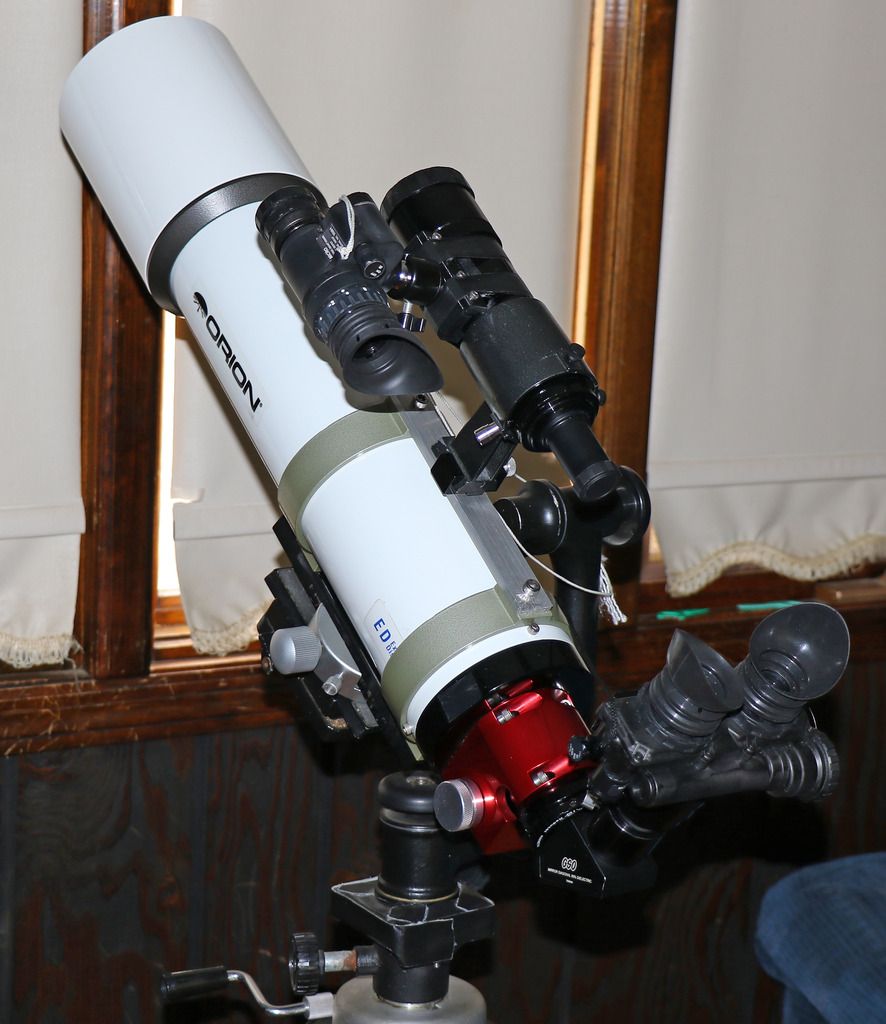
Very interesting and a great idea. With NODS, it so amazing how many faint emissions you can spot without any magnification. |
|
|
Tactical Night Vision Corporation - TNVC, INC.
http://www.tnvc.com [email protected] (909) 796-7000 "Eliminating our adversaries 940nm at a time" |
|
Originally Posted By cchurchi:
I will never forget the night I watched a totally insane meteor shower for about 3 hours with a couple of perfect TNV/PVS14's. There was no moon and I was in the middle of nowhere on a mountain top so there was 0 ambient light. It was like world war 3 had started and the entire cast of star wars had shown up to participate. View Quote Nice! That is definitely one of those moments that you remember for the rest of your life. |
|
|
|
|
Here's another of my favorite setups. It's an 8X Newcon Optik catadioptric lens with a gold or goldish plated mirror.
I figured out a way to use 1.25" astronomy filters with it and it's amazing on nebulae, clusters, and larger galaxies. Newcon Optik 8X The insert image link doesn't work for me. It gives me a "?" |
|
|
|
|
Originally Posted By KayakSteve:
Here's another of my favorite setups. It's an 8X Newcon Optik catadioptric lens with a gold or goldish plated mirror. I figured out a way to use 1.25" astronomy filters with it and it's amazing on nebulae, clusters, and larger galaxies. Newcon Optik 8X The insert image link doesn't work for me. It gives me a "?" View Quote Hmmm, then just copy the IMG link and paste it direct like I did below. What filters have you found work well with NV? I would be curious to hear what you tried with green phosphor? 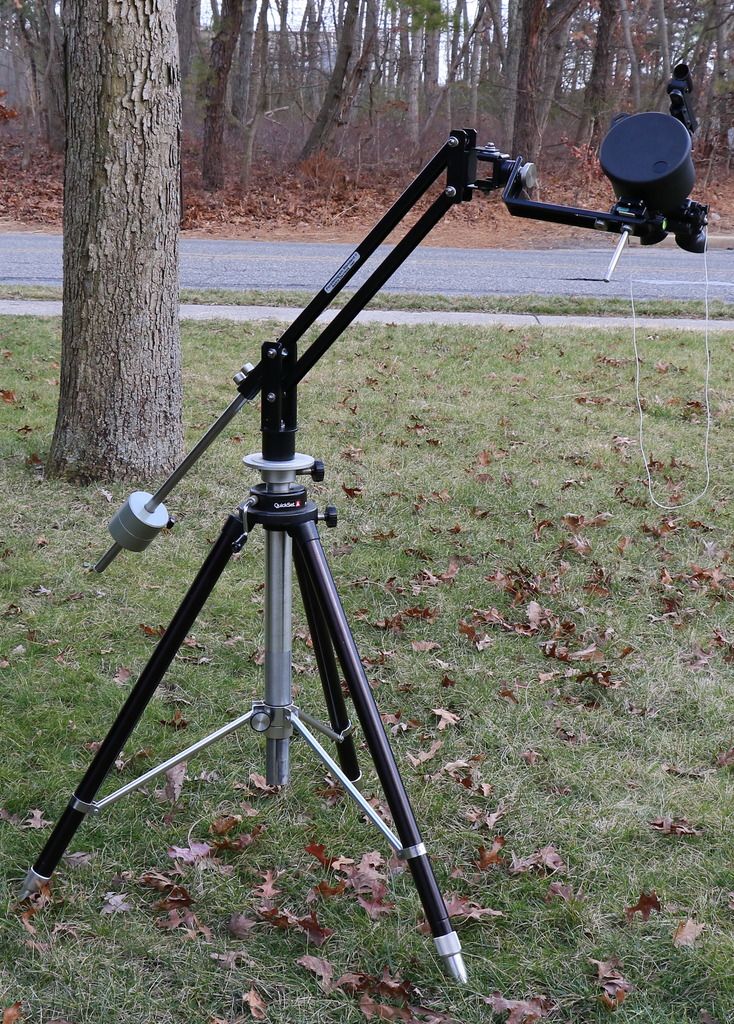
|
|
|
Tactical Night Vision Corporation - TNVC, INC.
http://www.tnvc.com [email protected] (909) 796-7000 "Eliminating our adversaries 940nm at a time" |
|
"Hmmm, then just copy the IMG link and paste it direct like I did below. What filters have you found work well with NV? I would be curious to hear what you tried with green phosphor?"
This is the list of filters that I have tried in order of their usefulness and application; Lumicon Night Sky Hydrogen Alpha filter-General light pollution filter for galaxies, clusters, and the Milky Way. Optolong Night Sky Hydrogen Alpha CCD Filter-Same performance as the Lumicon 12nm Hydrogen Alpha filter-All hydrogen emission nebulae such as M42, Barnard's Loop, M16, M17, M20, the Rosette, etc. 7nm Hydrogen Alpha filter-Same as 12nm with higher contrast but more scintillation "noise" due to photocathode being starved of photons. 4.5nm Hydrogen Alpha filter-Same as 12 and 7nm filters but with ultra high contrast with even more "noise." 35nm Hydrogen Alpha filter-Hydrogen emission nebulae with much lower contrast but higher light throughput than the other narrow band filters. I never observe without some kind of filter even on the best nights in the darkest skies available to me in my NJ Shore location. The filters work with Green and White Gen 3 and in my XR5 Onyx but the XR5 does not offer the same performance on nebulae that the Gen 3 tubes provide. Close but no cigar. |
|
|
|
|
I forgot to add that visual filters like H-Beta, OIII, visual light pollution reduction, etc. do nothing to enhance NV views.
|
|
|
|
|
PVS-7 Video
I shot this 1/28/17 with a Canon DSLR attached to a PVS-7 that was inserted into a 150mm f5 refractor. |
|
|
|
|
Originally Posted By KayakSteve:
PVS-7 Video I shot this 1/28/17 with a Canon DSLR attached to a PVS-7 that was inserted into a 150mm f5 refractor. View Quote  Orion Nebula (M42) Through a Gen 3 PVS-7 Thanks for posting Orion. I took some WPT Filmless pics of Orion a few nights ago. I will post up shortly with the tube specs and conditions. |
|
|
Tactical Night Vision Corporation - TNVC, INC.
http://www.tnvc.com [email protected] (909) 796-7000 "Eliminating our adversaries 940nm at a time" |
|
I took this overexposed shot by holding a DSLR with a 60mm macro lens up to the eyepiece of a PVS-7 with a Photonis XR5 Onyx tube.
The scope was a Vixen 102EDSS refractor. XR5 Onyx Orion Nebula Vic, I have too many NODs already but I think I have to talk you about an L3 filmless. |
|
|
|
|
Originally Posted By KayakSteve:
I took this overexposed shot by holding a DSLR with a 60mm macro lens up to the eyepiece of a PVS-7 with a Photonis XR5 Onyx tube. The scope was a Vixen 102EDSS refractor. XR5 Onyx Orion Nebula Vic, I have too many NODs already but I think I have to talk you about an L3 filmless. View Quote Made it hot for you. 
|
|
|
Tactical Night Vision Corporation - TNVC, INC.
http://www.tnvc.com [email protected] (909) 796-7000 "Eliminating our adversaries 940nm at a time" |
|
Here is my report and pics of Orion from a few nights back.
Sky Conditions - Very transparent, but a lot of turbulence due to a storm that just passed a few days earlier. - City sky glow Location - Southern Kalifornia - Elevation at location, 2100ft. - Temp - 52deg F - Humidity - 20% - Time of Night - 2130hrs Equipment Used - Celestron C11 CPC Series - 11" (279mm) Aperture - Focal Length - 2800 f/10 ***1764mm f/6.3 reducer not used in this session*** - Alignment Method - 2 Star - 40mm Tele Vue Plossl (1.25" adapter used with Tele Vue 2" Star Diagonal) - 21mm Tele Vue ETHOS - Tele Vue Proto PVS-14 Objective Lens Adapter - TNV-14 installed with L3 Mil Spec Omni 8 White Phosphor Filmless - 38.2 S/N - 82LP - .8 EBI - 2563 Photocathode - Galaxy S7 Edge on-board camera - Tele Vue FoneMate No narrow band H-a filters were used in these shots below of M42 Orion Nebula. The views below are in no way represented on how good the native eye through the eyepiece looked. It was stunning. No special doctoring of the photo's where attempted, nor any photoshop work. These are the raw images from the Galaxy S7. The gain was turned down on the 21mm ETHOS pics to mitigate some scintillation. The 40mm Plossl, the gain was full up and a bit nosier as you can see. 40mm Tele Vue Plossl 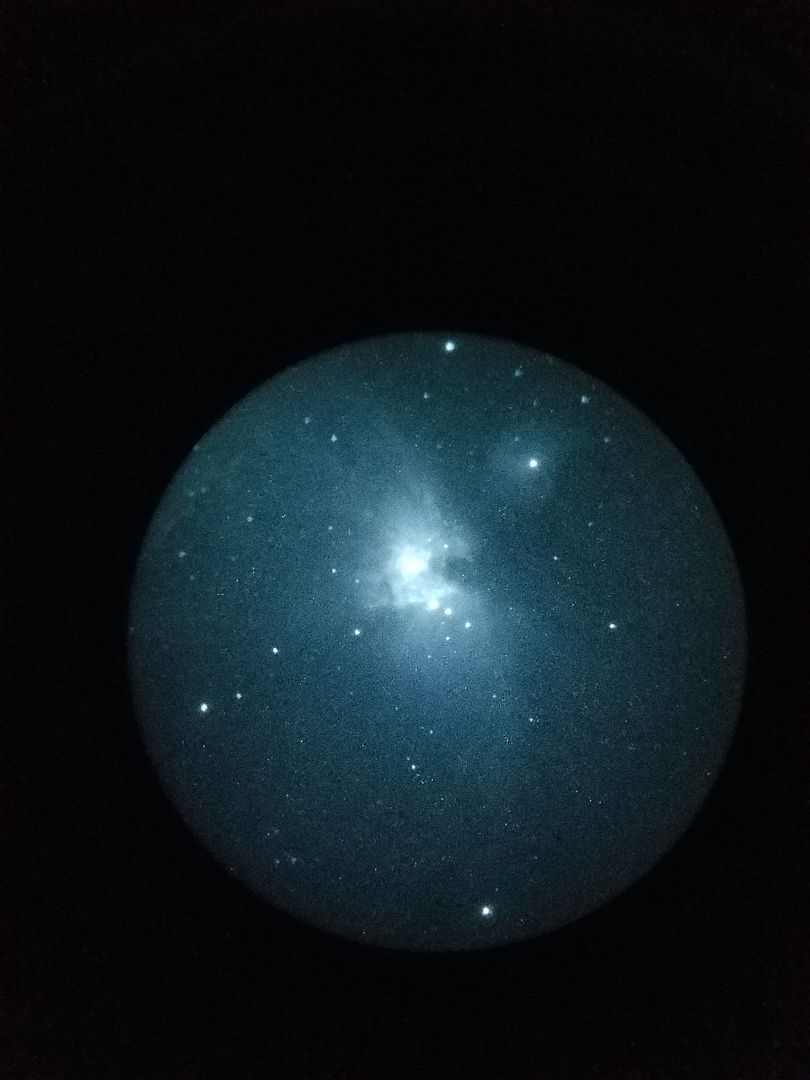
21mm Tele Vue ETHOS 
|
|
|
Tactical Night Vision Corporation - TNVC, INC.
http://www.tnvc.com [email protected] (909) 796-7000 "Eliminating our adversaries 940nm at a time" |
|
Really good stuff Vic!
I haven't seen too many photos that come close to replicating the actual eyepiece view. One guy that goes by JDB_Astro on Youtube has published a few processed photos that are very close to what the eyeball actually sees as opposed to the camera. I've thought about trying the stacking technique to process photos but this NOD astronomy is too new to me and I can't tear myself away from the views long enough to do any serious photography. |
|
|
|
|
Originally Posted By KayakSteve:
Really good stuff Vic! I haven't seen too many photos that come close to replicating the actual eyepiece view. One guy that goes by JDB_Astro on Youtube has published a few processed photos that are very close to what the eyeball actually sees as opposed to the camera. I've thought about trying the stacking technique to process photos but this NOD astronomy is too new to me and I can't tear myself away from the views long enough to do any serious photography. View Quote Have you tried both techniques? Direct through the tele tube NV (I guess with a Barlow of some sort to get the magnification) vs. a NVD, piggybacked off the telescope eye piece? I've heard some say a bit too much noise going the piggyback technique, but I see splendid results piggybacking with the PVS-14 with both the Tele View 40mm Plossl and the 21mm ETHOS (but limited FOV with that one due to eye relief and some vignetting), but the Plossl is a beauty with the piggybacking. Gonna try a MOD-3 tomorrow night direct through the tube but this time with green filmed for both (PVS-14 as well) I do not have many 82LP/38.2 Signal to noise units laying around. Edit, also going to run the piggybacking with the 40mm Plossl with a Tele View 2x Barlow and the PVS-14 as well. |
|
|
Tactical Night Vision Corporation - TNVC, INC.
http://www.tnvc.com [email protected] (909) 796-7000 "Eliminating our adversaries 940nm at a time" |
|
Originally Posted By TNVC:
Have you tried both techniques? Direct through the tele tube NV (I guess with a Barlow of some sort to get the magnification) vs. a NVD, piggybacked off the telescope eye piece? I've heard some say a bit too much noise going the piggyback technique, but I see splendid results piggybacking with the PVS-14 with both the Tele View 40mm Plossl and the 21mm ETHOS (but limited FOV with that one due to eye relief and some vignetting), but the Plossl is a beauty with the piggybacking. Gonna try a MOD-3 tomorrow night direct through the tube but this time with green filmed for both (PVS-14 as well) I do not have many 82LP/38.2 Signal to noise units laying around. Edit, also going to run the piggybacking with the 40mm Plossl with a Tele View 2x Barlow and the PVS-14 as well. View Quote I've tried afocal, NOD held in place over an eyepiece, but I prefer the NOD with a C-mount to 1.25" tube in the diagonal with or without a barlow. The narrow band Hydrogen-Alpha filters that I use to observe nebulae limit light throughput to such an extent that you have quite a bit of noise that only increases with focal ratio. My favorite scope for nebulae viewing is a 150mm f5 refractor. Globular clusters and galaxies are better in my 8" SCT even though it's f10. The TeleVue refractors are excellent for NOD astronomy due to their excellent optics and relatively short focal lengths. |
|
|
|
|
Originally Posted By KayakSteve:
I've tried afocal, NOD held in place over an eyepiece, but I prefer the NOD with a C-mount to 1.25" tube in the diagonal with or without a barlow. The narrow band Hydrogen-Alpha filters that I use to observe nebulae limit light throughput to such an extent that you have quite a bit of noise that only increases with focal ratio. My favorite scope for nebulae viewing is a 150mm f5 refractor. Globular clusters and galaxies are better in my 8" SCT even though it's f10. The TeleVue refractors are excellent for NOD astronomy due to their excellent optics and relatively short focal lengths. View Quote Since I have not tried anything but my 2800mm (f/10) Celestron C11 SCT, not sure going straight through the tube will show me any noticeable difference with the NVD? Have your tried both ways in your 8" SCT? Learning here what you see the different viewing experience between the two? I've read from others the like the non-Afocal but not really read the why's? Also can you link the best Hydrogen-Alpha's filters you've used? I've used some of the other Orion O2 stuff in the past with good results. How does this ONE rate? |
|
|
Tactical Night Vision Corporation - TNVC, INC.
http://www.tnvc.com [email protected] (909) 796-7000 "Eliminating our adversaries 940nm at a time" |
|
Originally Posted By TNVC:
Since I have not tried anything but my 2800mm (f/10) Celestron C11 SCT, not sure going straight through the tube will show me any noticeable difference with the NVD? Have your tried both ways in your 8" SCT? Learning here what you see the different viewing experience between the two? I've read from others the like the non-Afocal but not really read the why's? Also can you link the best Hydrogen-Alpha's filters you've used? I've used some of the other Orion O2 stuff in the past with good results. How does this ONE rate? View Quote I have tried afocal with the SCT and I found it to be okay for small targets like galaxies and globular clusters but I normally just insert the NOD into a barlow before placing it in the diagonal for more magnification. The reasons that I go straight into a diagonal are no vignetting, least amount of glass for highest possible light throughput, widest FOV possible, and ease of use. I cobbled together a way to go afocal but a well engineered dedicated adapter would be far more useful for the times that you want go through an eyepiece. That Orion filter has gotten good reviews from at least one guy on Cloudy Nights. I highly recommend a narrow band, 12nm or narrower, Hydrogen Alpha filter for anyone who wants to stargaze with a NOD. There are countless nebulae that can only be seen with these filters and on a clear dark night the views can be surreal. The following are all filters that I routinely use. I just picked up my second 4.5nm filter. The 4.5nm with a 3X magnifier is beyond description, it really is one of those seeing is believing things. 4.5nm Hydrogen Alpha filter Light Pollution Filter Light Pollution filter 12nm Hydrogen Alpha filter |
|
|
|
|
Vic,
You could pick up an 80mm f5 refractor to mount on top of your SCT. You could put a C-mount monocular or C-mount equipped PVS-7 into a diagonal and have ULTRA wide fields to compliment the narrow FOV of the Schmidt. scroll down to see the set up |
|
|
|
|
Anyone have any Andromeda pics or vids?
|
|
|
|
|
Originally Posted By cchurchi:
Anyone have any Andromeda pics or vids? View Quote This guy, jdb_astro, posts some great stuff. The photos that I have taken of M31 are too crummy to post! Andromeda Galaxy (M31) |
|
|
|
|
Originally Posted By KayakSteve:
Vic, You could pick up an 80mm f5 refractor to mount on top of your SCT. You could put a C-mount monocular or C-mount equipped PVS-7 into a diagonal and have ULTRA wide fields to compliment the narrow FOV of the Schmidt. scroll down to see the set up View Quote Interesting, I like. Going out tonight to test out some green filmed with both behind the 40mm Plossl and the Mod-3 directly into the scope with a 2x barlow. Moon is out earlier tonight, so that stinks so may be out late when it sets. So did you see any difference with the piggyback NVD behind the EP with your f/10 SCT vs. through the tube direct? I am not using the 6.3 reducer just yet, I want to look at both techniques. I am guessing the noise will be the same with such a large focal length with both techniques. So far I am liking the Tele Vue 40mm Plossl with virtually no vignetting and getting the full 50deg FOV due to the adapter design hitting the sweet spot of the Plossl, exit pupil and eye relief. With my 21mm ETHOS pic above, you can see the vignetting and of course, I am at 70deg FOV vs the colossal 100deg with real eye viewing. |
|
|
Tactical Night Vision Corporation - TNVC, INC.
http://www.tnvc.com [email protected] (909) 796-7000 "Eliminating our adversaries 940nm at a time" |
|
Originally Posted By TNVC:
Interesting, I like. Going out tonight to test out some green filmed with both behind the 40mm Plossl and the Mod-3 directly into the scope with a 2x barlow. Moon is out earlier tonight, so that stinks so may be out late when it sets. So did you see any difference with the piggyback NVD behind the EP with your f/10 SCT vs. through the tube direct? I am not using the 6.3 reducer just yet, I want to look at both techniques. I am guessing the noise will be the same with such a large focal length with both techniques. So far I am liking the Tele Vue 40mm Plossl with virtually no vignetting and getting the full 50deg FOV due to the adapter design hitting the sweet spot of the Plossl, exit pupil and eye relief. With my 21mm ETHOS pic above, you can see the vignetting and of course, I am at 70deg FOV vs the colossal 100deg with real eye viewing. View Quote I have mostly used the straight through technique with all of my scopes sometimes with a 2X barlow. The key to using the afocal method is a sturdy way to hold the NVD over the eyepiece. Just handholding it is difficult at best. I do like the afocal method when observing certain objects, planetary nebulae and globular clusters are prime targets for high power. If you have not used a night vision/telescope combo to look at a decent globular cluster like M15, M2, or M13 you have not lived! They resolve to their cores in a 4" refractor. I have found that the two largest factors for night vision astronomy are sky transparency and good Hydrogen Alpha filters. A transparent, dark night with good filters and an NVD is a visual astronomer's dream come true. I don't want anyone to think that a telescope is necessary to stargaze with an NVD. I actually enjoy 1X and 3X immensely and I always have an NVD set up like that even when I have the scope out too. The scope just lets you see smaller objects and increases detail in some of the larger objects. |
|
|
|
|
Originally Posted By KayakSteve:
I have mostly used the straight through technique with all of my scopes sometimes with a 2X barlow. The key to using the afocal method is a sturdy way to hold the NVD over the eyepiece. Just handholding it is difficult at best. I do like the afocal method when observing certain objects, planetary nebulae and globular clusters are prime targets for high power. If you have not used a night vision/telescope combo to look at a decent globular cluster like M15, M2, or M13 you have not lived! They resolve to their cores in a 4" refractor. I have found that the two largest factors for night vision astronomy are sky transparency and good Hydrogen Alpha filters. A transparent, dark night with good filters and an NVD is a visual astronomer's dream come true. I don't want anyone to think that a telescope is necessary to stargaze with an NVD. I actually enjoy 1X and 3X immensely and I always have an NVD set up like that even when I have the scope out too. The scope just lets you see smaller objects and increases detail in some of the larger objects. View Quote Understand about the retention of the NOD with the afocal system, it's been a longstanding issue. I have looked at M13, you're very correct. Tonight was a bust with too much darn haze and cloudiness...Front moving in. |
|
|
Tactical Night Vision Corporation - TNVC, INC.
http://www.tnvc.com [email protected] (909) 796-7000 "Eliminating our adversaries 940nm at a time" |
|
"Tonight was a bust with too much darn haze and cloudiness...Front moving in. "
That's why I fish too! |
|
|
|
|
Tactical Night Vision Corporation - TNVC, INC.
http://www.tnvc.com [email protected] (909) 796-7000 "Eliminating our adversaries 940nm at a time" |
|
Tactical Night Vision Corporation - TNVC, INC.
http://www.tnvc.com [email protected] (909) 796-7000 "Eliminating our adversaries 940nm at a time" |
|
What a cool thread. I can't wait to try with my TNV L3 film-less WPs.
|
|
|
|
|
Tactical Night Vision Corporation - TNVC, INC.
http://www.tnvc.com [email protected] (909) 796-7000 "Eliminating our adversaries 940nm at a time" |
|
Originally Posted By TNVC:
Besides the obvious gunplay with NODS, the sky is an amazing treat many overlook. You will enjoy immensely. View Quote ... but in the event that someone needs a practical application for looking at the stars with NVD because they're too busy being serious to have a good time, I posit this: Many stars will reveal themselves under I2 making navigation by starlight more practical under less than ideal weather conditions. There are limits, of course, but some minimal mastery of the stars is good insurance against failure of electronic navigation systems. Beyond being a ninja tool, NVDs will provide an abundant amount of information about our environment that you will never notice until you unwind and have a good time. When I am being serious, I look right through the NVD like it's not even there - but I didn't get to that point of relaxation by being uptight under I2 every moment I'm using it. |
|
|
|
|
Originally Posted By TNVC:
Pic taken from last weeks winter Star Party in the Florida keys using our TNV-14 L3 Filmless from a users 32 inch scope. Hope to show the incredible video from this scope. http://img.photobucket.com/albums/v621/Clutch99/Neb_zpsrrfoujnl.jpg View Quote I would have loved a view through that setup! The Orion Nebula is a good test to determine whether or not you're going to be into astronomy. If you are not blown away by M42 in an NVD astronomy is definitely not a hobby you should pursue. |
|
|
|
|
Originally Posted By KayakSteve:
I would have loved a view through that setup! The Orion Nebula is a good test to determine whether or not you're going to be into astronomy. If you are not blown away by M42 in an NVD astronomy is definitely not a hobby you should pursue. View Quote So much agree here....M42 is pretty special and using NODS in a light polluted city where you usually cannot see much along with so many deep sky objects that an NVD opens up the sky to, is phenomenal. |
|
|
Tactical Night Vision Corporation - TNVC, INC.
http://www.tnvc.com [email protected] (909) 796-7000 Dedicated to the men and women in uniform who fight the good fight. |
|
Originally Posted By KayakSteve:
PVS-7 Video I shot this 1/28/17 with a Canon DSLR attached to a PVS-7 that was inserted into a 150mm f5 refractor. View Quote Incredible. |
|
|
|
|
Originally Posted By TNVC:
Here is my report and pics of Orion from a few nights back. Sky Conditions - Very transparent, but a lot of turbulence due to a storm that just passed a few days earlier. - City sky glow Location - Southern Kalifornia - Elevation at location, 2100ft. - Temp - 52deg F - Humidity - 20% - Time of Night - 2130hrs Equipment Used - Celestron C11 CPC Series - 11" (279mm) Aperture - Focal Length - 2800 f/10 ***1764mm f/6.3 reducer not used in this session*** - Alignment Method - 2 Star - 40mm Tele Vue Plossl (1.25" adapter used with Tele Vue 2" Star Diagonal) - 21mm Tele Vue ETHOS - Tele Vue Proto PVS-14 Objective Lens Adapter - TNV-14 installed with L3 Mil Spec Omni 8 White Phosphor Filmless - 38.2 S/N - 82LP - .8 EBI - 2563 Photocathode - Galaxy S7 Edge on-board camera - Tele Vue FoneMate No narrow band H-a filters were used in these shots below of M42 Orion Nebula. The views below are in no way represented on how good the native eye through the eyepiece looked. It was stunning. No special doctoring of the photo's where attempted, nor any photoshop work. These are the raw images from the Galaxy S7. The gain was turned down on the 21mm ETHOS pics to mitigate some scintillation. The 40mm Plossl, the gain was full up and a bit nosier as you can see. 40mm Tele Vue Plossl http://img.photobucket.com/albums/v621/Clutch99/40mm%20Plossl_zpshurrc3ie.jpg 21mm Tele Vue ETHOS http://img.photobucket.com/albums/v621/Clutch99/21mm%20Ethos_zps4dwzvx3z.jpg View Quote Stunning. You guys kill me. I see this stuff and have to run out and buy it. And I assume it's probably at least ten grand. And I'll use it twice a year lol. |
|
|
|
|
Originally Posted By NothingClever:
Stunning. You guys kill me. I see this stuff and have to run out and buy it. And I assume it's probably at least ten grand. And I'll use it twice a year lol. View Quote A telescope is nice to have but night vision astronomy is geared toward seeing really faint or normally invisible objects. Many nebulae are far too large to be appreciated in a telescope and really shine at 1X to 3X. It's also mind blowing just to look up and see tens of thousands of stars on a clear and moonless night! The minimum requirements to get into NVD astronomy is a decent Gen 3 device, no need for the ultra high end stuff, a few filters that go in front of the optics, and an auxiliary lens like a 3X. Some NVDs, a PVS-7 for example, can be easily adapted for use with camera lenses. The scope in the link is a great candidate for NVD astronomy that will also be useful for "normal" astronomy. It will be great for solar system objects like the rings of Saturn and close up views of lunar craters. You can go less expensive too but this scope comes on a "Go To" mount that will let you tour the sky without having to use star charts and a finder scope. NVD Scope |
|
|
|
|
Originally Posted By KayakSteve:
A telescope is nice to have but night vision astronomy is geared toward seeing really faint or normally invisible objects. Many nebulae are far too large to be appreciated in a telescope and really shine at 1X to 3X. It's also mind blowing just to look up and see tens of thousands of stars on a clear and moonless night! The minimum requirements to get into NVD astronomy is a decent Gen 3 device, no need for the ultra high end stuff, a few filters that go in front of the optics, and an auxiliary lens like a 3X. Some NVDs, a PVS-7 for example, can be easily adapted for use with camera lenses. The scope in the link is a great candidate for NVD astronomy that will also be useful for "normal" astronomy. It will be great for solar system objects like the rings of Saturn and close up views of lunar craters. You can go less expensive too but this scope comes on a "Go To" mount that will let you tour the sky without having to use star charts and a finder scope. NVD Scope View Quote |
|
|
Tactical Night Vision Corporation - TNVC, INC.
http://www.tnvc.com [email protected] (909) 796-7000 Dedicated to the men and women in uniform who fight the good fight. |
|
Here is a recent Florida Star Party in the Keys with a video of our L3 TNV-14 White Phosphor Al Nagler was using with this users 32-inch, f3.6 Dobsonian telescope. Obviously the real time views of this EP were so MUCH better than what the Vid shows, but still pretty cool all the detail that is seen that cannot be seen naked eye though the scope without any light amplification. Enjoy...
 Failed To Load Title |
|
|
Tactical Night Vision Corporation - TNVC, INC.
http://www.tnvc.com [email protected] (909) 796-7000 Dedicated to the men and women in uniform who fight the good fight. |
|
Televue is legendary and I am glad you are working with Mr Nagler as I have no doubt epicness will be the result.
I am going to call you guys tomorrow and order a PVS-14...can't wait to work with you over the phone. The only telescope I own is my Leica APO Televid 77 which is actually a fantastic spotting scope and a decent refractor for casual sky use. My Leica 10x50's and 8X42's are also fantastic for viewing meteor showers...but my old ITT 45LPM res anvis tube rig picks up weird stuff that is otherwise invisible. Gen 3 is fun!!! |
|
|
|
|
Speaking of TeleVue, they just posted a fantastic article on the Night Vision and telescopes and really cleared up some misnomers on AFOCAL (using a PVS-14 piggy backed) vs. Prime Focus methods.
http://televue.com/notamnomen/2017/04/25/about-the-neaf-night-vision-demonstration/#.WP_DQTckrDA |
|
|
Tactical Night Vision Corporation - TNVC, INC.
http://www.tnvc.com [email protected] (909) 796-7000 Dedicated to the men and women in uniform who fight the good fight. |
|
Tele Vue and TNVC telescope adapter will be realessed at the end of this month. Price will be announced in a few weeks. Thanks guys.
|
|
|
Tactical Night Vision Corporation - TNVC, INC.
http://www.tnvc.com [email protected] (909) 796-7000 Dedicated to the men and women in uniform who fight the good fight. |
|
Tactical Night Vision Corporation - TNVC, INC.
http://www.tnvc.com [email protected] (909) 796-7000 Dedicated to the men and women in uniform who fight the good fight. |
|
We are getting very close. Everything is complete, we should have the new adpaters up on our web site by this weekend with final pricing etc. We are VERY pleased how this turned out in the form fit and function arena. Enjoy some of the new pics.
This is the PVS-14 objective eyepiece ring, The thread side threads directly to the PVS-14 lens and the other securely clamps to the telescope eye piece. 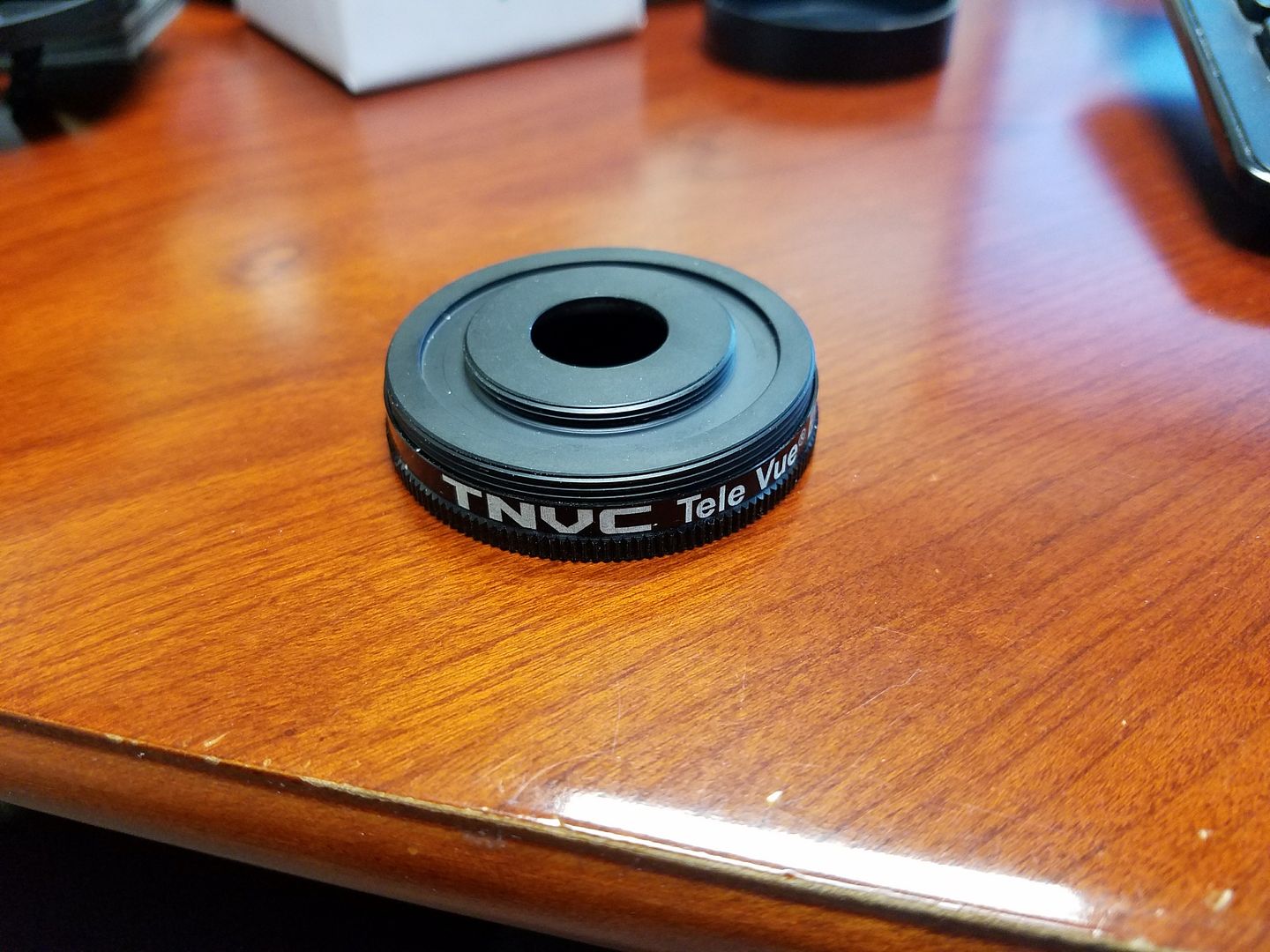
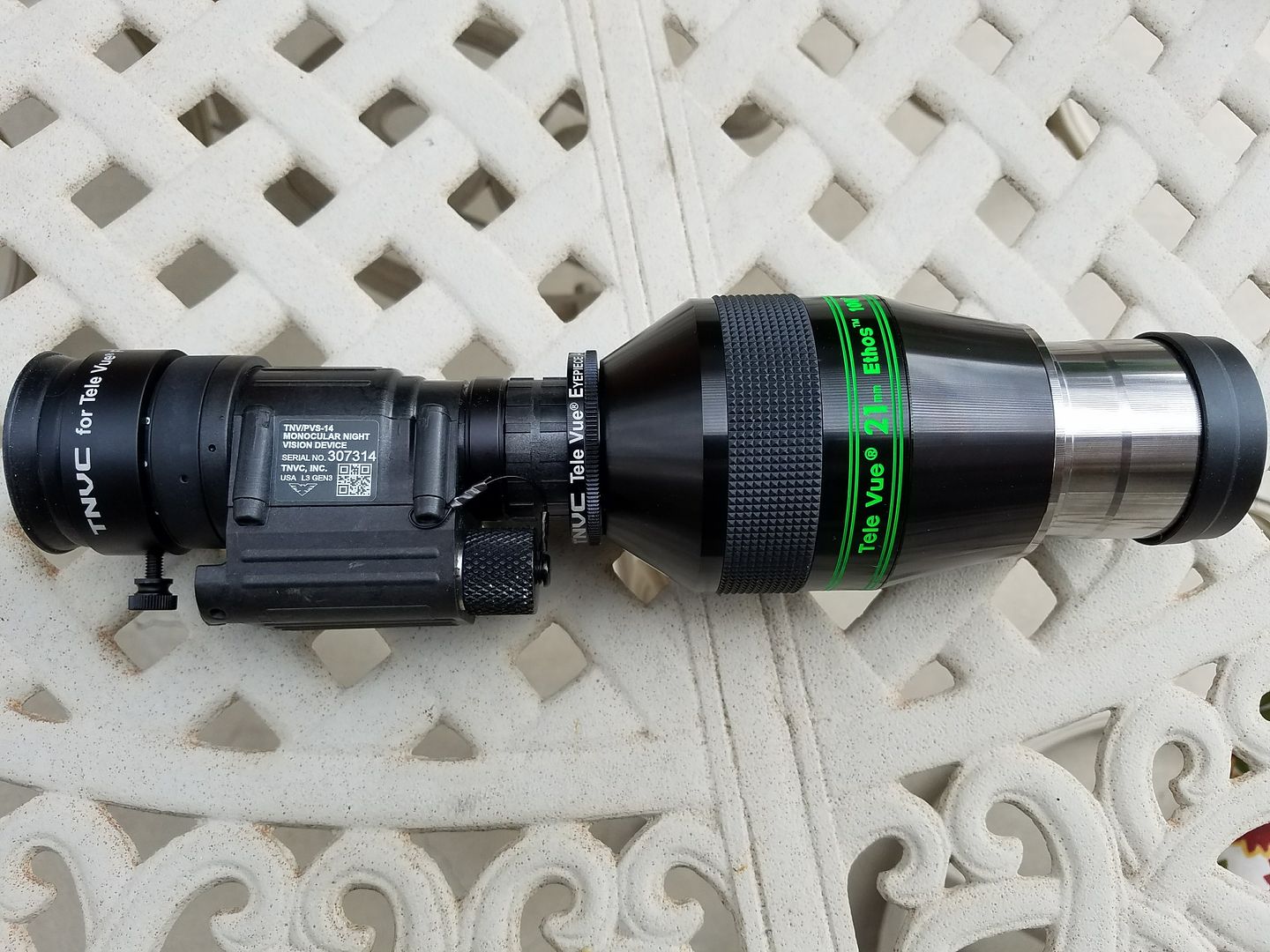
This is the PVS-14 rear ocular adapter that allows the use of Tele Vue's FoneMate which I feel is the best smart phone adapter to date that allows for just about any smart phone out there. Androids, I-Phones, etc. The adapter has a brass compression ring insert that allows the adapter to clamp down on the rear diopter ring without marring and still allows for diopter adjustment while the adapter is in place! 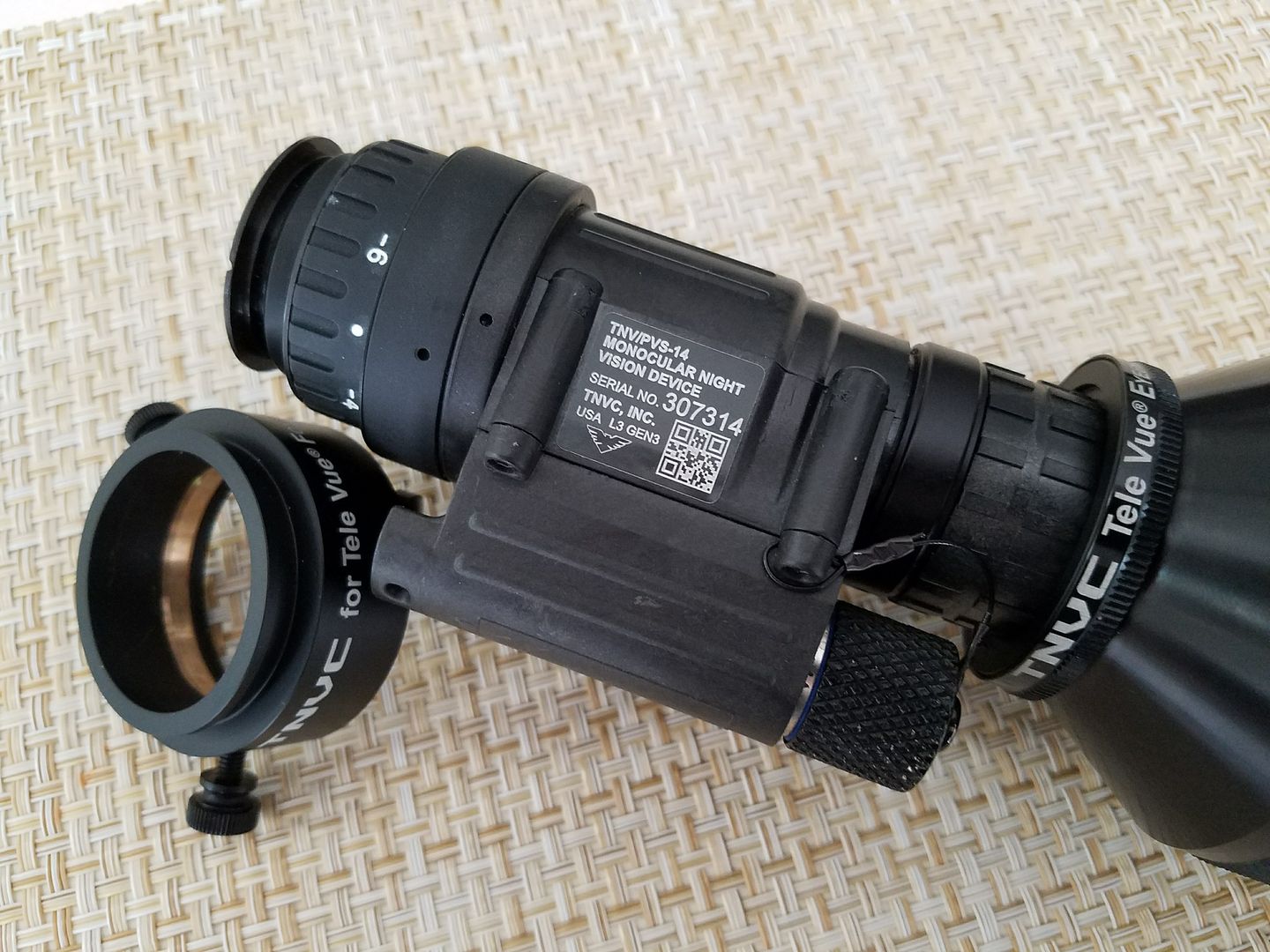
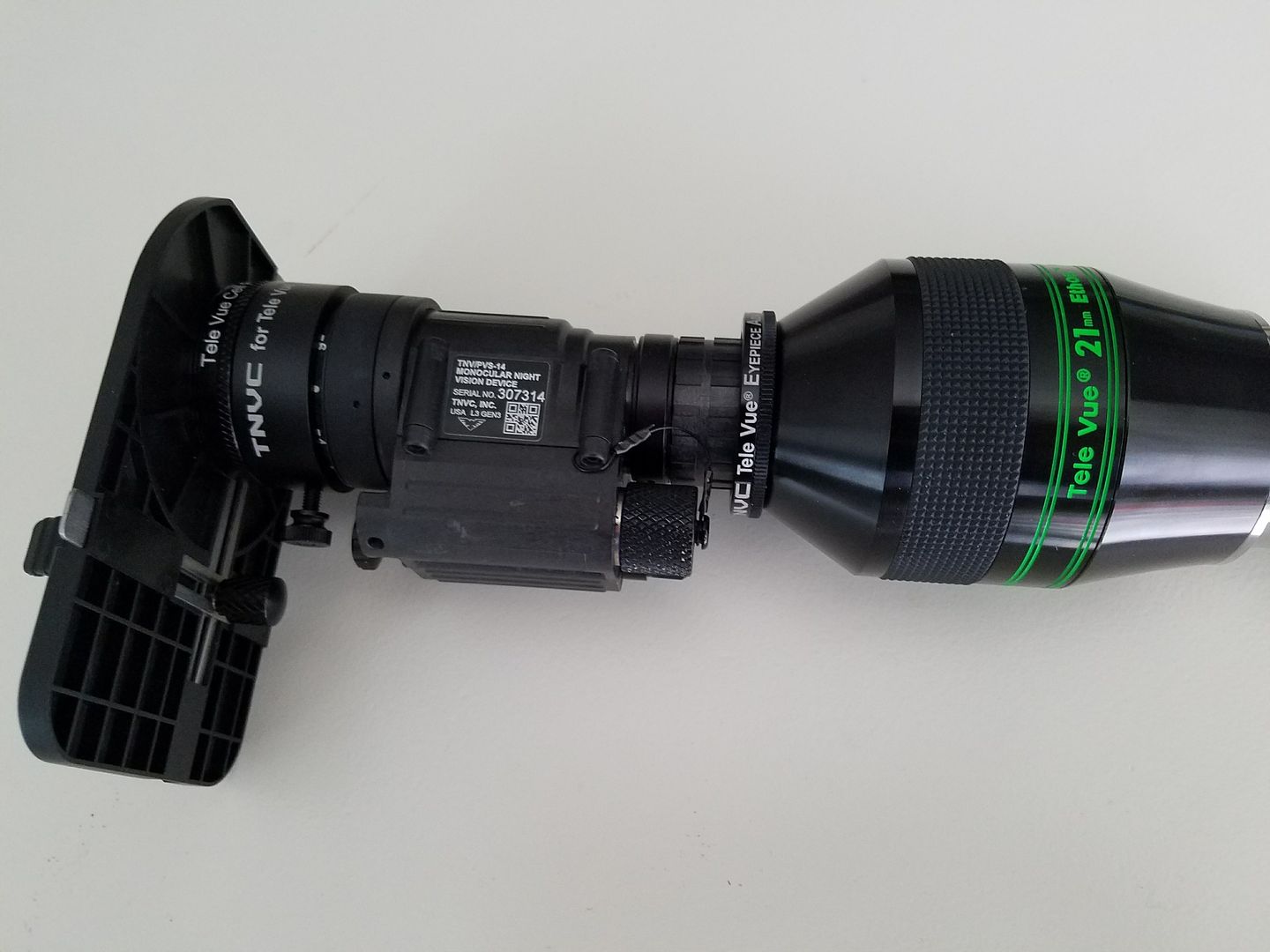
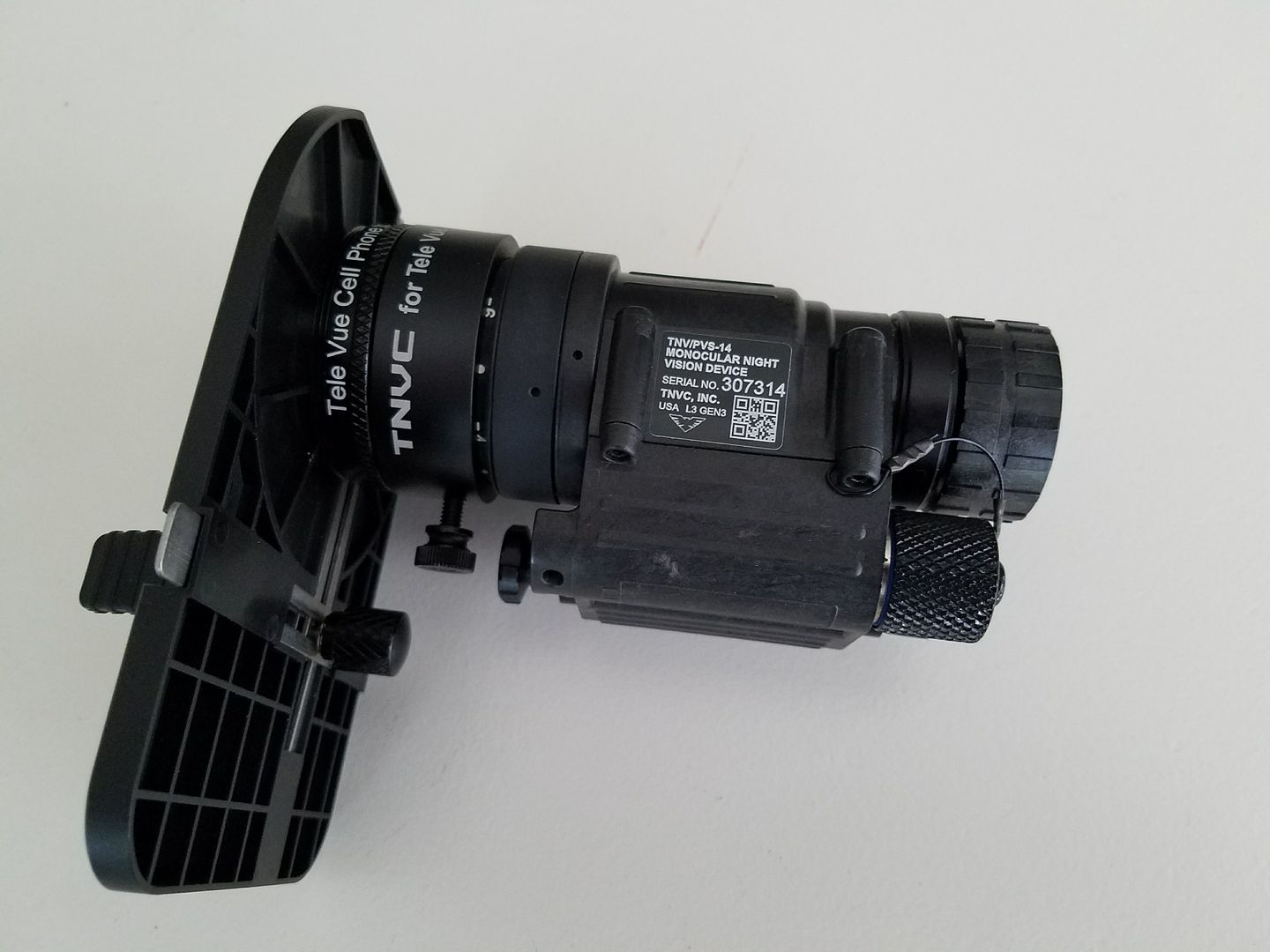
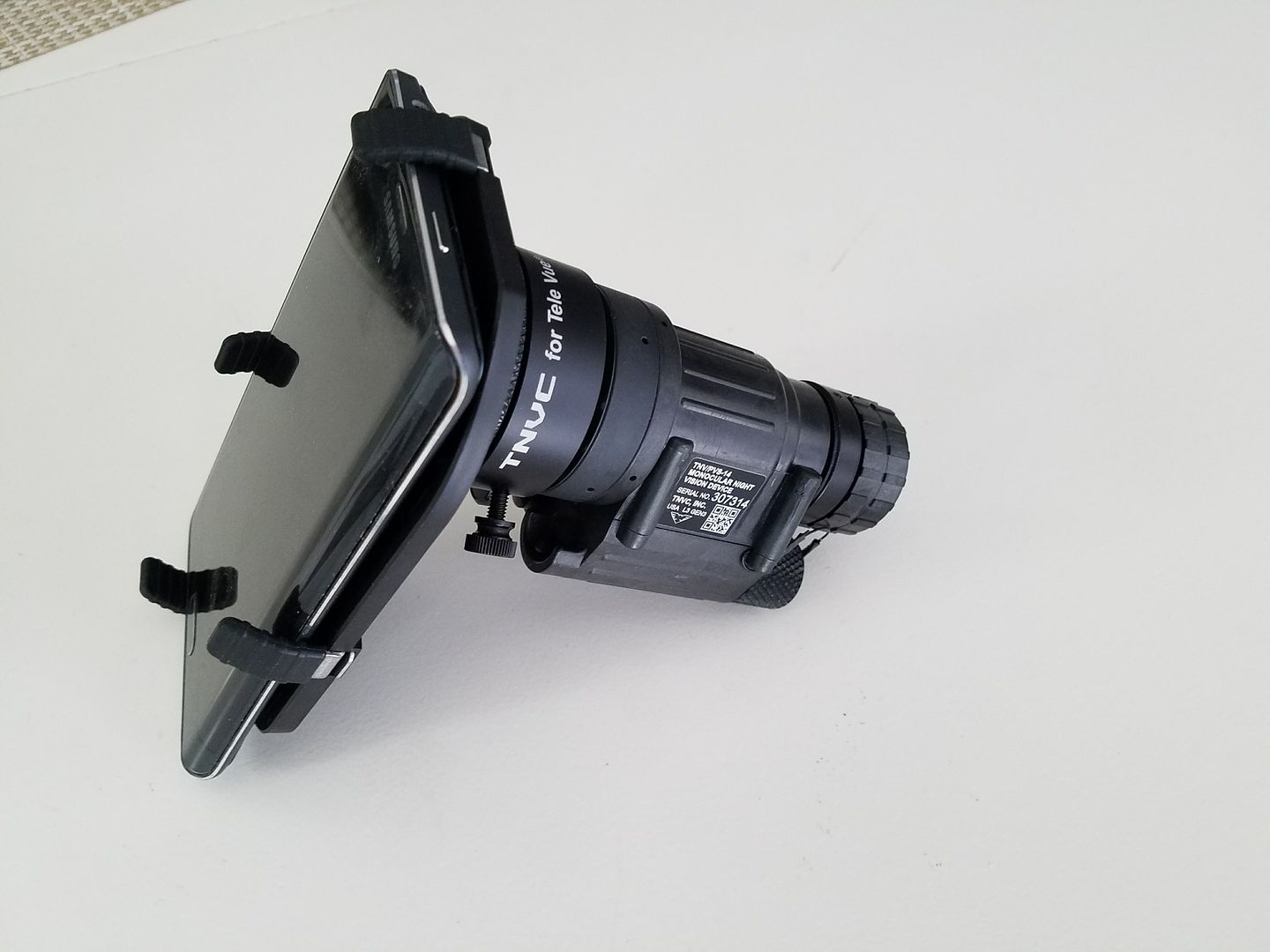
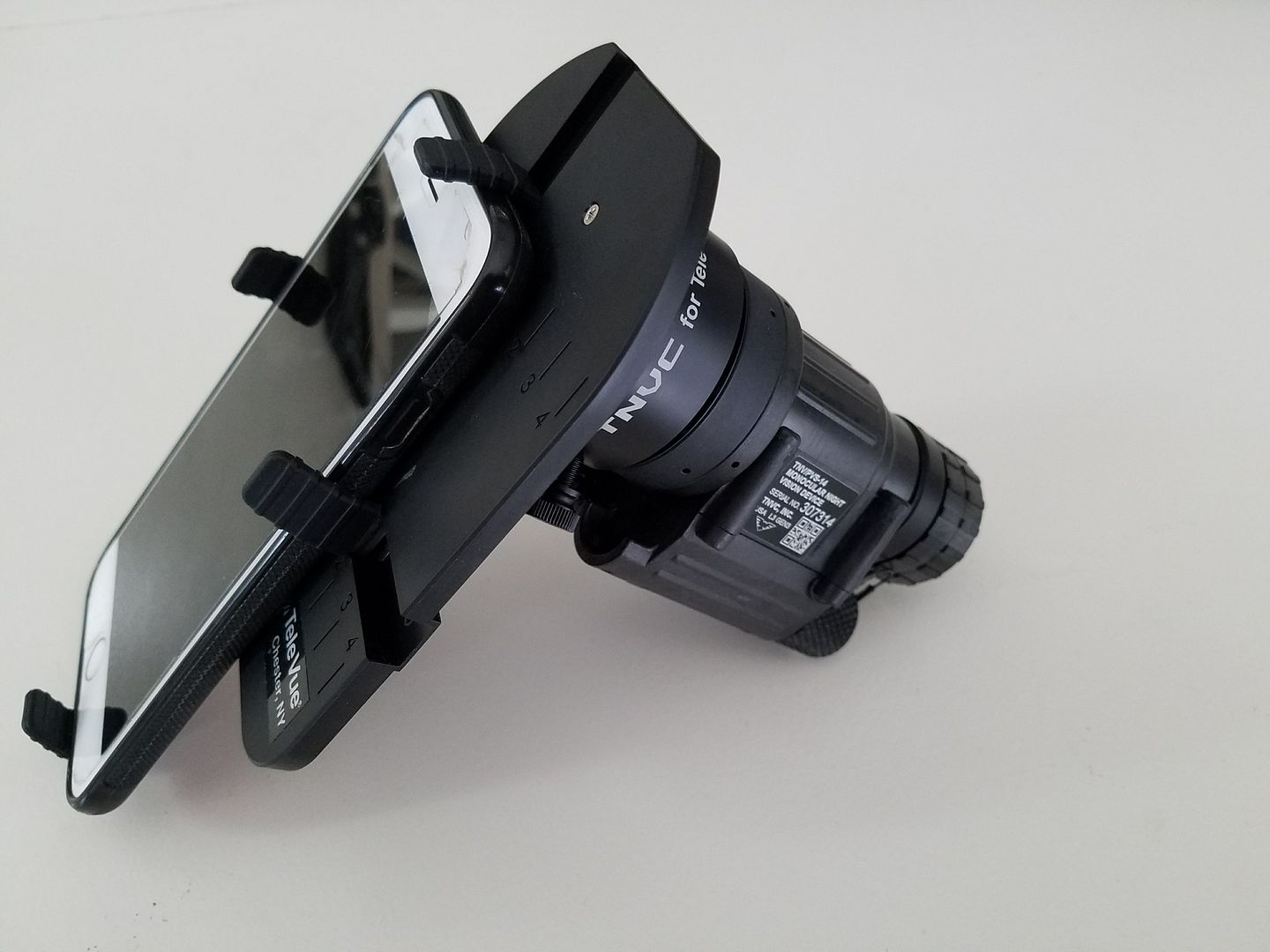
The FoneMate/Adapter will also be sold separately as well to fill a niche for all those stand alone PVS-14 owners out there! More to come... |
|
|
Tactical Night Vision Corporation - TNVC, INC.
http://www.tnvc.com [email protected] (909) 796-7000 Dedicated to the men and women in uniform who fight the good fight. |
|
Now live and available HERE.
|
|
|
Tactical Night Vision Corporation - TNVC, INC.
http://www.tnvc.com [email protected] (909) 796-7000 Dedicated to the men and women in uniform who fight the good fight. |
|
Tactical Night Vision Corporation - TNVC, INC.
http://www.tnvc.com [email protected] (909) 796-7000 Dedicated to the men and women in uniform who fight the good fight. |
|
Restored.
|
|
|
You only live once, but if you live right.. once is enough.
|
|
Tactical Night Vision Corporation - TNVC, INC.
http://www.tnvc.com [email protected] (909) 796-7000 Dedicated to the men and women in uniform who fight the good fight. |
|
I have a Celestron Celestar 8 Deluxe I got around 1999 or 2000.
With this scope you have to set up the wedg correctly to pole north. It's a great scope and has a good tracking drive for photography, but it's all on you to set up level and find stuff. I learned allot about astronomy with this scope. To bad i forgot most of it 
I hear the new mounts do everything for you now. I guess I'm going to have to get some adaptors from you all now and dust off my scope. |
|
|
Black holes matter
Life Member of the National Rifle Association Proud LaRue Fan |
 Win a FREE Membership!
Win a FREE Membership!
Sign up for the ARFCOM weekly newsletter and be entered to win a free ARFCOM membership. One new winner* is announced every week!
You will receive an email every Friday morning featuring the latest chatter from the hottest topics, breaking news surrounding legislation, as well as exclusive deals only available to ARFCOM email subscribers.
AR15.COM is the world's largest firearm community and is a gathering place for firearm enthusiasts of all types.
From hunters and military members, to competition shooters and general firearm enthusiasts, we welcome anyone who values and respects the way of the firearm.
Subscribe to our monthly Newsletter to receive firearm news, product discounts from your favorite Industry Partners, and more.
Copyright © 1996-2024 AR15.COM LLC. All Rights Reserved.
Any use of this content without express written consent is prohibited.
AR15.Com reserves the right to overwrite or replace any affiliate, commercial, or monetizable links, posted by users, with our own.

